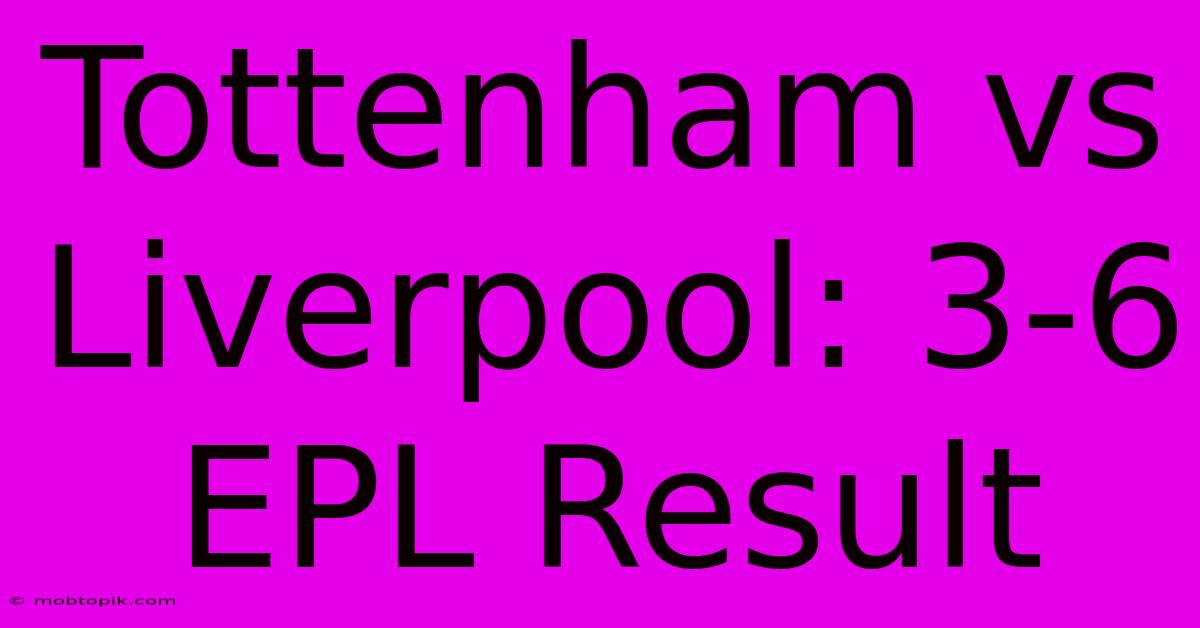Tottenham Vs Liverpool: 3-6 EPL Result

Discover more detailed and exciting information on our website. Click the link below to start your adventure: Visit Best Website mobtopik.com. Don't miss out!
Table of Contents
Tottenham Hotspur vs. Liverpool: A 3-6 Thriller – A Tactical Breakdown and Analysis
The Premier League clash between Tottenham Hotspur and Liverpool on [Insert Date of Match] delivered a pulsating encounter that ended in a thrilling 6-3 victory for the Reds. While the final scoreline suggests a comfortable win for Liverpool, the match was a rollercoaster of goals, tactical shifts, and individual brilliance. This detailed analysis delves into the key aspects of the game, exploring the tactical approaches employed by both managers, highlighting individual performances, and examining the factors that contributed to the high-scoring affair.
A High-Octane Start: Early Goals and Tactical Approaches
The game exploded into life from the first whistle. Liverpool, employing a high-pressing, aggressive style under [Liverpool Manager's Name], immediately sought to overwhelm Tottenham's backline. Their front three of [Liverpool's Forwards] caused havoc with their pace and movement, stretching Spurs' defense and creating numerous early chances. Tottenham, under [Tottenham Manager's Name], initially attempted to absorb the pressure and hit on the counter, utilizing the pace of [Tottenham's Wingers]. However, Liverpool's intensity proved too much to handle in the early stages.
Liverpool's dominance in the opening stages stemmed from several factors:
- High Pressing: Their relentless pressing forced errors in Tottenham's passing, winning back possession in dangerous areas.
- Fluid Attacking Movement: The constant interchange of positions among Liverpool's attackers created confusion in Tottenham's defense.
- Exploiting Space: Liverpool effectively exploited the space behind Tottenham's full-backs with their quick, direct passing.
Tottenham's early struggles were evident in their defensive vulnerabilities. Their inability to consistently win aerial duels and their hesitant decision-making under pressure led to several crucial mistakes that Liverpool capitalized on ruthlessly.
Tottenham's Response and Tactical Adjustments
Despite falling behind early, Tottenham showed resilience and tactical flexibility. [Tottenham Manager's Name]'s adjustments in the second half were particularly noteworthy. The introduction of [Substitute Player's Name] injected fresh impetus into their attack, providing a different dynamic and increasing their attacking threat. A shift to a more direct style of play, bypassing midfield and aiming for quick transitions, allowed them to create more scoring opportunities and reduce Liverpool's dominance. This tactical shift showcased the manager's ability to adapt to the changing dynamics of the game and respond to Liverpool's pressure. This period demonstrated a fascinating strategic battle between the two managers.
Individual Performances: Stars and Struggles
Several players delivered standout performances, influencing the game's outcome significantly.
Liverpool's standouts:
- [Liverpool Player's Name]: His contribution was pivotal. [Detailed description of his performance, including goals scored, assists, key passes, and overall impact on the game].
- [Liverpool Player's Name]: [Detailed description of his performance].
- [Liverpool Player's Name]: [Detailed description of his performance].
Tottenham's noteworthy performances:
- [Tottenham Player's Name]: Despite the heavy defeat, [Tottenham Player's Name]'s performance was commendable. [Detailed description of his performance, highlighting positive aspects].
- [Tottenham Player's Name]: [Detailed description of his performance].
Analyzing Tactical Flaws and Strengths
Liverpool's Strengths:
- Clinical Finishing: Liverpool's ability to convert their chances was remarkable, showcasing their clinical edge in front of goal.
- Effective Pressing: Their high-energy pressing disrupted Tottenham's rhythm and created turnovers in dangerous areas.
- Attacking Versatility: Their varied attacking approach, utilizing both width and central penetration, proved incredibly effective.
Liverpool's Weaknesses:
- Defensive Lapses: While their attack was dominant, occasional defensive lapses allowed Tottenham to score goals and briefly regain momentum.
Tottenham's Strengths:
- Resilience: Despite the scoreline, Tottenham's refusal to give up and their tactical adjustments in the second half demonstrated their resilience and fighting spirit.
- Individual Brilliance: Some Tottenham players delivered outstanding performances in patches, showcasing their individual talent.
Tottenham's Weaknesses:
- Defensive Instability: Their defensive vulnerabilities were exposed repeatedly, particularly in the first half.
- Inconsistent Attacking Pressure: They struggled to maintain consistent attacking pressure throughout the match.
Conclusion: Lessons Learned and Future Implications
The Tottenham vs. Liverpool match was a captivating encounter that showcased both the attacking prowess of Liverpool and the resilience of Tottenham. While the final scoreline reflects a significant victory for Liverpool, Tottenham's tactical adjustments and individual brilliance in certain periods highlight their potential. For Liverpool, the match demonstrated their ability to dominate possession and create a plethora of scoring opportunities. For Tottenham, the game underscores the need for improved defensive stability and maintaining consistent attacking pressure to challenge top-tier opponents. The match offered valuable lessons for both teams, shaping their approaches in future encounters. This high-scoring game served as a compelling example of attacking football and the strategic nuances within a top-flight Premier League clash. The analysis of this match provides valuable insights into team tactics, individual brilliance, and the rollercoaster nature of elite-level football.

Thank you for visiting our website wich cover about Tottenham Vs Liverpool: 3-6 EPL Result. We hope the information provided has been useful to you. Feel free to contact us if you have any questions or need further assistance. See you next time and dont miss to bookmark.
Also read the following articles
| Article Title | Date |
|---|---|
| Spadaro Eagles Win Streak Ends At 36 | Dec 23, 2024 |
| Spurs 3 6 Liverpool Premier League Match | Dec 23, 2024 |
| Live Score Tottenham Vs Liverpool Match | Dec 23, 2024 |
| Liverpool Thrash Tottenham 6 3 | Dec 23, 2024 |
| Spadaro On Eagles 36 Point Loss | Dec 23, 2024 |
